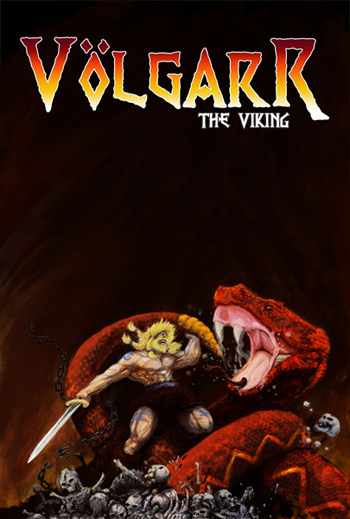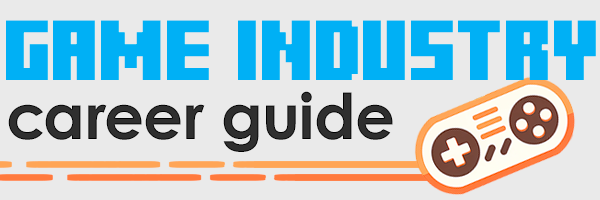Expert Guest: Kris Durrschmidt, Indie Developer (Part 2 of 2)

Kris Durrschmidt is the co-founder, CEO and creative director of Crazy Viking Studios, an indie game development shop in the Seattle area.
In Part 1 of this interview (which you should definitely check out), we talked about life as a self-employed indie dev, the ups and downs of having complete creative control, and how to stay motivated. In Part 2, we chat about running a Kickstarter, the future of the videogame industry, and some advice for devs starting their careers in games. (And – bonus! – the unsavory art portfolio that landed Kris his first industry job!)
Kickstart My Heart
You guys did a Kickstarter to raise your initial funding, can you talk about that?
Finances are a tricky thing. I don’t mind sharing ours. The hard fact is that if you include the combined lost salaries of Taron and I, plus the lost benefits and other compensation we lost by not working in the job force, then add in the funds from Kickstarter and subtract other game-related expenses, Volgarr will have cost about $250,000 to build. Which may initially sound like a lot of money, but for a game like this that is very cheap. We are also making it with just 2 primary developers and a contract audio engineer. To put things in perspective, a game of this scope at my last employer would have been in the range of $700k and have been made with a team of 7 or more. Every time someone asks me about this and I start to explain it I remember how absolutely crazy I must have been to try this. [Laughs]
Taron and I didn’t have a whole lot saved up to start this company. It came about rather abruptly for us and we had to move quickly. Fortunately we both have very very loving and understanding wives that believe in us and in our vision, who have taken on the brunt of the financial responsibility while we get our first game shipped. We were also lucky to have been able to do a few side contracts in the meantime to help lighten the financial burden.
KICKSTARTER CAMPAIGN IS LIVE!! GO GO GO! http://t.co/0iVNxc3W
— Crazy Viking Studios (@VOLGARR) July 23, 2012
Is that a path you’d recommend to other indies?
We approached Kickstarter in a different way than I think most do. We didn’t want them to fund the whole game, but to help us get over the hump to make it a reality. We did not think it was fair to go to Kickstarter with our hand out without justifying that we are just as invested as anyone that might be giving us money. Especially in a poor economy.
So rather than just launch a Kickstarter campaign and ask for money before we started working on the game, we spent a good 6 months creating the engine, refining the core mechanics and the design. Before we came to Kickstarter we knew exactly what our game was, what it was going to be and could demonstrate how fun it was. Before asking for a cent. I got rid of my fancy sports car I loved dearly (and a lot of other personal stuff) to finance getting to that point. I wanted people to know that I had way more riding on this and I was serious (but of course in a lighthearted and often silly manner). We viewed Kickstarter as a way to lighten our burden a little, and to get the word out there and get people excited about what we were doing.
However, the game was going to get done, Kickstarter or not. It certainly helped make things a little less stressful in some ways, but caused problems in others. For instance, Volgarr would probably be done by now if we hadn’t taken on those contract gigs or spent a month and a half full time on the Kickstarter campaign. Running a Kickstarter is a full-time job while preparing and during its runtime. That takes away from actually working on your game. On the other hand, without the Kickstarter funds and the contracts we took on, while delaying us for about 6 months, I would be several thousands of dollars in debt right now and hoping to sell enough units of the game to recuperate my losses.
Megadeth is a great way to keep the brain functioning beyond exhaustion to get work goals done.
— Crazy Viking Studios (@VOLGARR) June 26, 2013
Is there anything you wish you’d done differently?
I always knew I wanted to have my own game studio. It had been a dream of mine since before I ever set foot in Griptonite Games. I should have saved my money when I could. That would have made things a lot easier in the end. Make sure you have a solid financial plan before anything else. You don’t want to not be able to see a doctor if you are sick or have your lights shut off on you.
As far as Kickstarter goes? Even if you have never made a game before, you need to demonstrate that you can with a VERY good prototype or demo that shows exactly what the game is going to be like. For example a fully-finalized level from the game as it would appear in the final product, one that you are proud of. Don’t use only sketches and concept art and mock-up videos. Show gameplay! That is king! Spend the time to make a good video. Not only do you need to show people why they should want to play your game, but you need to sell yourselves as the people behind it.
People will buy into why you do something more than why they need it. A good example is, “I am making this game because I believe games have been greatly lacking in precise combat design. So I have taken it upon myself to give that to you and this is how I am going to do it.” Next thing you know, potential backers are thinking “Yah I feel like that too! How come there is no game like that for ME?!” You make a connection to your audience, sell them on your belief, then yourself, then your product. The most IMPORTANT thing is to respect your backers and be open and honest, have regular communication with them and deliver on your promise.
The Indie Renaissance
The game industry is changing. Many studios are downsizing or closing, and jobless devs are starting their own teams instead of rejoining the studio system. Do you think that’s a temporary side effect, or a longer-term industry trend?
It is a healthy part of a healthy and growing industry. Studio closures happen every time a major console cycle comes to an end. Lots of new studios grow and form around the new hardware.
Because tools, engines and middleware have become increasingly easy to use, there has never been a better time to be an independent developer if you can manage it. The really big focus in the last couple years was on explosive mobile-space growth. In my opinion it is a little too big. Look for that space to be the next to shrink in the next 2-3 years, or consolidate into a few major players and then everyone else. There are probably going to be lots of mobile studio closures that buckle under the weight of the competition. It isn’t going away but it will stabilize and get smaller.
The interesting thing to watch is how the indie game scene is getting ready to experience a renaissance age. Microsoft, Nintendo, Sony, Steam, Amazon and more are all poised to battle it out for prime indie devs and games. We typically take on development risks on our own and when we have a hit we maximize on profit. Not to mention our games don’t cost $60. Usually less than the price of a single pizza.
You’ve been working on your current title for months, and now it’s about time to release it. What emotions are hitting you guys at this particular moment?
We are freaking out. Very tired. I worked almost 80 hours last week. Broke and Hungry. Loving every second of it. We can’t wait to get the game in the hands of the public and find out what they think of it. The greatest reward for us would be if enough people bought enough copies of the game to support us, so we can simply keep making games we love and we hope they love too. At the end of the day that would make us the most happy. Making games that make other people happy and being able to pay the bills.
@TommyRefenes Feel like I'm going to puke and/or pass out I'm such a nervous wreck, it gets better after the game launches? #exhausted
— Crazy Viking Studios (@VOLGARR) August 5, 2013
Hard Work and A Little Luck
What are the top skills/talents that a dev must have to succeed as an indie?
Top indie talent typically wear multiple hats. Be good at programming and art. Or programming and design. Or design and art, or whatever combination. You must be disciplined and motivated and remember that making games is HARD work. On top of everything else, even if you have the best game in the world you need to know how to connect to people, to sell yourself and your game. Make friends with as many people as you can. Build good relationships and keep your promises.
I heard a story about your very first interview with a professional game studio, back in 2002. It involved you having some… how to put this… “questionable” subject matter in your portfolio. Can you talk about that? [Laughs]
Yeah that is a WEIRD story. I called a phone number in an advertisement for a job as a Police Sketch Artist. Turns out there was a mistake in the ad and it actually had the number for a game studio. Somehow I landed a phone interview anyway and then did an art test with a very fast turn-around time. That landed me an on-site interview.
The job I had applied for was as an environment artist. The problem was, I didn’t have a portfolio. I did have some hastily-made games I had created that I brought with me for interviewers to play. When they asked if I had a portfolio, I thought my shot at getting the job was over.
I had just moved to the west coast from Baltimore and I was struggling to make ends meet. I sold used cars, bar-tended, did what I had to do to pay the bills – and at that time I had been illustrating pornographic images for a German website. They were paying me $75 for each 8.5” x 11” black and white. I had a stack of those in my suitcase in the car that I was planning to mail out after the interview so I could buy groceries. So when I was asked if I had a portfolio or any traditionally-drawn art, I politely said: “I don’t have a portfolio, but I do have some traditionally-drawn art. But I have to warn you it is really graphic.”
I think they thought I meant graphic as in violent. [Laughs.] I got the case and brought it in. The looks of shock and awe over bringing a suitcase of pornography to a job interview was pretty hilarious (and super scary for me at the time). Needless to say I got the job! To this day I don’t know how, but I did. Especially, unknown to me at the time of the interview, the company primarily did games for children.
Do Dragons have NIPPLES?! Should they? I think so…. http://t.co/UaV8XbUxzm
— Crazy Viking Studios (@VOLGARR) July 25, 2013
What advice do you have for students that are just entering the job market?
Don’t give up. While you are working on getting that sweet job you should be spending any extra time you have bettering yourself. There is nothing more impressive to employers than someone who has the fortitude to make a game on their own time. Make something, anything. Make it part of your portfolio or resume. Once you land that sweet gig you can have time to relax… until you are crunching in milestone week, anyway. [Laughs]
Kristofor Durrschmidt has worked in the videogame industry for over a decade as a Lead Artist and a Lead Designer. He took started his own indie game studio in 2012. Kris can be reached via LinkedIn or at Crazy Viking Studios.
If you liked this interview, please share it on Facebook, LinkedIn or Twitter.
Read my new book!
Making games for a living is an incredibly rewarding career, but it’s hard to break in unless you have insider knowledge. This book levels the playing field.


Leave a Reply